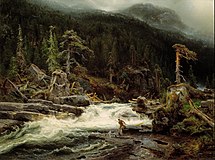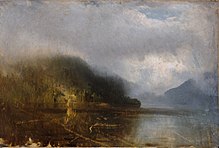August Cappelen

Herman August Cappelen (born May 1, 1827 in Skien , Telemark , † July 8, 1852 in Düsseldorf ) was a Norwegian painter from the Düsseldorf School .
Life
Cappelen grew up as the son of the ironworks owner Diderik von Cappelen (1795–1866) and the noble Severine Margrethe Henriette Løvenskiold (1796–1866), a sister of State Minister Severin Løvenskiold , on the Holden estate near Ulefoss . After he had finished school in Skien in 1845, he went to Christiania to study at university , where he met Hans Fredrik Gude , who recommended that he go to Prussia at the Düsseldorf Art Academy . In the years 1845/1846 and 1849/1850 he attended Johann Wilhelm Schirmer's class for landscape painting . Schirmer, with whom he had a good student-teacher relationship, shaped Cappelen through his ideal landscapes and his composition techniques. From 1850 to 1852 he was a member of the Malkasten artists' association . Cappelen went on several study trips, in the summer of 1846 together with Gude and Johan Fredrik Eckersberg to Gudbrandsdalen and Bøverdalen , in the summer of 1847 to Sogn and Hardanger . The painter and Schirmer student August Becker followed Cappelen's references to picturesque forest motifs on his second trip to Norway. The painters August Leu and Georg Saal accompanied him. During a longer stay in Ulvik , they all met again. During the German Revolution of 1848/1849 , Cappelen traveled home like many Norwegians. In March 1849 he experienced a major event in Norwegian national romanticism at a charity event in the Christiania Theater , when, to a text by Andreas Munch and music by Halfdan Kjerulf, the painting Brudeferd i Hardanger (Bridal Trip on the Hardangerfjord), which was painted in 1848 by the painters Gude and Adolph Tidemand had been composed in Düsseldorf when the set was shown. Cappelen died at the age of 25 in Düsseldorf, probably from a tumor in his abdomen that had caused him problems since the spring of 1852. After a temporary burial in Düsseldorf, his family had his body transferred to Norway.
Work (selection)
Cappelens preferred motifs were forest landscapes , as he already knew them in his youth from the area around the Holden family estate. As a romantic, he was interested in unspoilt, mysterious forests with wild, torn and decaying trees. On the death bed he is said to have fantasized about the South American forests. His last picture, the dying jungle , which shows an almost apocalyptic scenario of death and decay, remained unfinished. It proves his mood-enhancing and independent use of colors. The choice and execution of his tree motifs influenced the painters Morten Müller and Erik Bodom , who shared the studio with him, on Marcus Larson and Lars Hertervig , for example on his painting Skogstjern (Waldsee) from 1865.
- Tree study , 1850, Oslo National Museum
- Study of a decaying tree trunk , 1851, Oslo National Museum
- After the storm , 1851
- Waterfall in Telemark , 1852, Oslo National Museum
- Lake Svarttjern (Black Pond) , 1852, private collection
- Utdøende urskog (Dying Primeval Forest, Decaying Forest) , 1852, National Museum Oslo
gallery
literature
- Cappelen, Hermann August . In: Friedrich von Boetticher : painter works of the nineteenth century. Contribution to art history . Volume 1, Dresden 1891, p. 160.
- Carl Wille Schnitler : Cappelen, Herman August . In: Ulrich Thieme (Hrsg.): General Lexicon of Fine Artists from Antiquity to the Present . Founded by Ulrich Thieme and Felix Becker . tape 5 : Brewer-Carlingen . EA Seemann, Leipzig 1911, p. 547 ( Textarchiv - Internet Archive ).
- Sigurd Willoch: August Cappelen og the romantic landscape art . 1928.
- Düsseldorf and north . National Museum utställningskatalog, 1976, No. 51, 54.
- Wend von Kalnein : The Düsseldorf School of Painting . Verlag Philipp von Zabern, Mainz 1979, ISBN 3-8053-0409-9 , p. 280, no. 43, 44.
- Magne Malmanger: August Cappelen . Astrup Fearnley museet for modern art, 1997, catalog, 15.
- Bettina Baumgärtel (Ed.): The Düsseldorf School of Painting and its International Radiance 1819–1918 . Michael Imhof Verlag, Petersberg 2011, ISBN 978-3-86568-702-9 , Volume 1: pp. 178, 179, 182, 184, 361, 363, 404, 428; Volume 2: p. 231 f., Catalog no. 182, 183.
Web links
- August Cappelen at Google Arts & Culture
- August Cappelen . In: Norsk biografisk leksikon (website in portal nbl.snl.no )
- August Cappelen . In: Norsk kunstnerleksikon (website in portal nkl.snl.no )
- August Cappelen . In: Store norske leksikon (website in portal snl.no )
- Works by August Cappelen, Oslo National Museum, Norway
Individual evidence
- ↑ Bettina Baumgärtel , Sabine Schroyen, Lydia Immerheiser, Sabine Teichgröb: Directory of foreign artists. Nationality, residence and studies in Düsseldorf . In: Bettina Baumgärtel (Hrsg.): The Düsseldorf School of Painting and its international impact 1819–1918 . Volume 1, Michael Imhof Verlag, Petersberg 2011, ISBN 978-3-86568-702-9 , p. 428
- ^ Gabriele Ewenz: Sources for the Düsseldorf School of Painting 1825–1928 . In: Bettina Baumgärtel (Hrsg.): The Düsseldorf School of Painting and its international impact 1819–1918 . Volume 1, Michael Imhof Verlag, Petersberg 2011, ISBN 978-3-86568-702-9 , p. 404 (travel description by August Becker , entry from June 12, 1847)
- ^ Ernst Haverkamp: The Norwegian artists in Düsseldorf. The cultural transfer between Düsseldorf and the north . In: Bettina Baumgärtel (Hrsg.): The Düsseldorf School of Painting and its international impact 1819–1918 . Volume 1, Michael Imhof Verlag, Petersberg 2011, ISBN 978-3-86568-702-9 , p. 178
- ↑ See also the article Brudeferd i Hardanger in the Bokmål version of the Norwegian Wikipedia
- ↑ Ernst Haverkamp, p. 179
| personal data | |
|---|---|
| SURNAME | Cappelen, August |
| ALTERNATIVE NAMES | Cappelen, Herman August (full name) |
| BRIEF DESCRIPTION | Norwegian painter from the Düsseldorf School |
| DATE OF BIRTH | May 1, 1827 |
| PLACE OF BIRTH | Skien , Telemark |
| DATE OF DEATH | July 8, 1852 |
| Place of death | Dusseldorf |





